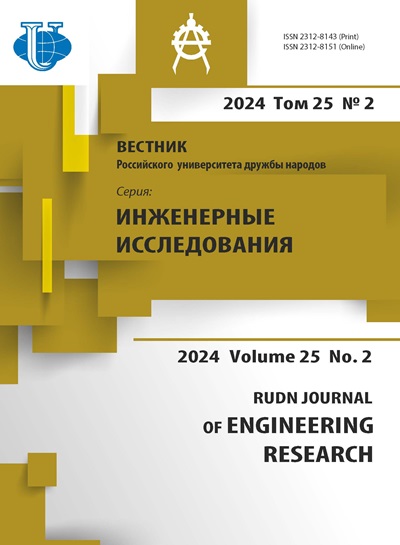Ways to assess of seismicity of the territory of Syria
- Authors: Dubyansky A.I.1, Aljabasini H.2
-
Affiliations:
- Voronezh State University
- Peoples’ Friendship University of Russia (RUDN University)
- Issue: Vol 20, No 1 (2019)
- Pages: 79-84
- Section: Earth science
- URL: https://journals.rudn.ru/engineering-researches/article/view/21427
- DOI: https://doi.org/10.22363/2312-8143-2019-20-1-79-84
Cite item
Full Text
Abstract
The article considers estimates of changes in the magnitudes of seismic events for two years (2005-2006) according to seismic catalogs. For this period, graphs of the law of repeatability of earthquakes were constructed and compared with each other. The analysis of the graphs of the frequency of occurrence of a number of zones built during seismic zoning was carried out, and the relationship between parameter A and the earthquake source mechanism was determined. Seismic zoning - the division of the territory into areas with varying degrees of intensity occurred and expected earthquakes. Seismic zoning data is used in the design and construction of earthquake-resistant structures and solving other practical problems in a seismically dangerous area. This is the applied aspect of seismic zoning. For the mapping of seismic zoning, historical data and instrumental observations of earthquakes, geological-tectonic and geophysical maps, as well as data on the movements of blocks of the earth’s crustare used. There are areas of possible occurrence of earthquake foci (OEF zones) with different depths. The greatest danger is represented by earthquakes with foci within the earth’s crust (at a depth of 3 to 30-50 km). The article provides a statistical analysis of the earthquakes of Syria for two years, taking into account historical earthquakes from the chronicles. The result of the work is the establishment of links between the identified earthquakes and the planetary events of the Earth, including solar activity. There is an increase in seismic activity in winter. Presented research should be used in forecasting future. It is worth noting that the basis for forecasting future natural events is the integration of analytical methods for analyzing data and theoretical ideas about the tectonics of the region in question.
Keywords
About the authors
Alexander I. Dubyansky
Voronezh State University
Author for correspondence.
Email: zaina40@hotmail.com
Candidate of Geological and Mineralogical Sciences, Associate Professor
1 University Sq., Voronezh, 394018, Russian FederationHiba Aljabasini
Peoples’ Friendship University of Russia (RUDN University)
Email: zaina40@hotmail.com
Postgraduate student of Geology, Department of Geology, Mining and Oil & Gas Engineering
6 Miklukho-Maklaya St., Moscow, 117198, Russian FederationReferences
- Aplonov SV. Geodynamics: textbook. Saint Petersburg: Publishing House of Saint Petersburg University; 2001. (In Russ.)
- Gorny VI, Amir O, Kafri A, Kiselev AV, Kritsuk SG, Latypov IS, Minini Kh. Regional geological structure of the North Arabian plate and prospects of oil and gas potential of the territory of Syria according to the complex processing of satellite and gravimetric survey results. Sovremennye problemy distantsionnogo zondirovaniya zemli iz kosmosa [Current problems in remote sensing of the Earth from space]. 2012;9(1): 305-312. (In Russ.)
- Devyatkin EV, Dodonov AE, Dobrova MR et al. Essays on the Geology of Syria. Tr. GIN RAS. Vol. 526. Moscow: Nauka Publ.; 2000. (In Russ.)
- Dubyansky AI, Aljabasini H. Some assessment of the regime of seismicity of the territory of Syria. Theory and practice of geological interpretation of geophysical fields: Proceedings of the 43rd session of D.G. Uspensky the International scientific seminar. Voronezh: Publishing and printing center “Scientific book”; 2016. p. 74-75.
- Olenin VB, Zverev OV, Selitsky AG. Oil and gas zoning of the Persian Gulf. Bull. Higher. Stud. Inst. Geology and Exploration Series. l 972;(2): 112-117.
- Seismological Bulletin from the Syrian National Seismological Network. www.nec.gov.sy (accessed: December, 2018).
- Abramov VYu, Dolginov EA. New dates of correlation a moons phases and earthquakes. Bulletin of the Peoples Friendship University of Russia. Series: Engineering research. 2013;(2): 37-44. (In Russ.)
- Omar HM, Tatevosyan RE, Rebetsky YL. The mechanism of earthquakes and stress state of earth crust in Syria // Herald KRAUNTS. Earth Science Series. 2012;2(20): 139- 147.
- Khain VYe, Lomize MG. Geotectonics with bases of geodynamics tutorial: for students of geological specialties of universities. Moscow: Moscow State University Publ.; 1995. (In Russ.)
- Abramov VYu, Jamus AD. Seysmicheskiiye given on the shelf in east part of the Mediterranean Sea [Seismic data on the shelf in the Eastern Mediterranean]. Innovation & Investment. 2017;(5): 150-154. (In Russ.)
- Abramov VYu, Makarovsky OV. Geologicheskaya interpretatsiya seismicheskikh dannykh [Geological interpretation of seismic data]. Moscow: RUDN Publ.; 2019. (In Russ.)
- Rebetsky YuL, Lucc AA, Tatevosyan RE, Bykova VV. Opredelenie lokal’nykh mekhanizmov slabykh zemletryasenii i sovremennaya geodinamika yuga Irana [Determination of focal mechanisms of weak earthquakes and modern geodynamics of southern Iran]. Geodynamics and Tectonophysics. 2017;8(4): 971-988.
- Sadovsky MA, Pisarenko VF. Seismicheskii protsess v blokovoi srede [Seismic process in block environment]. Moscow: Nauka Publ.; 1991. (In Russ).
- Global CMT catalog (2012). Available from: http:// ww w,globalcmt.org/CMTsearch.html (accessed: September, 2018).
- Hatem M. El Ssayd, Hussam E. Zaineh, Draji Dojcinovski, Vladimir Mihailov. Re-Evaluations of Seismic Hazard of Syria. International Journal of Geoscienes. 2012;(3): 847- 855.
- Sadooni FN, Alsharhan AS. Stratigraphy, microfacies, and petroleum potential of the Nauddud Formation (AlbianCenomanian) in the Arabian Jult basin. AAPG Bull. 2003;87(10): 1653-1680.
- Mohamad Khir Abdul-Wahed, Ibrahim Al-Tahham. Preliminary outline of the seismologically active zones in Syria. Annals of geophysics. 2010;53(4). doi: 10.4401/ag4683
- Rawaa Dakkak, Maen Mreish, Mohamad Daoud, George Hade. Seismological Research Letters. 2005;76(4): 437-445.
- Sadooni FN, Alsharhan AS. Stratigraphy, microfacies, and petroleum potential of the Nauddud Formation (AlbianCenomanian) in the Arabian Jult basin. AAPG Bull. 2003;87(10): 1653-1680.
















